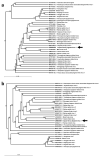Discovery of a Novel Jingmenvirus in Australian Sugarcane Soldier Fly (Inopus flavus) Larvae
- PMID: 35746612
- PMCID: PMC9229714
- DOI: 10.3390/v14061140
Discovery of a Novel Jingmenvirus in Australian Sugarcane Soldier Fly (Inopus flavus) Larvae
Abstract
In Australia, soldier flies are major pests of sugarcane, and they can cause significant yield losses in some areas, possibly due to the virus' transmission to the plants. We sequenced fly larvae salivary glands and identified a novel jingmenvirus, putatively named Inopus flavus jingmenvirus 1 (IFJV1). Phylogenetic trees confirmed that IFJV1 groups with insect-associated jingmenviruses, newly identified flavivirus-like viruses with a segmented genome. After the design and the validation of molecular detection systems for IFJV1, larval homogenates were passaged on insect and vertebrate cells, but IFJV1 could only be detected in the first two passages in insect cells and not at all in vertebrate cells. Despite this lack of consistent replication in laboratory models, this virus does replicate in its host Inopus flavus, as sequenced, small RNA from the larvae matched the IFJV1 sequences. Moreover, they were found to be predominantly 21 nucleotides long and map to the whole sequences on both strands, which is typical of an actively replicating virus. This discovery confirms the worldwide presence of jingmenviruses which, until now, had only been detected on four continents. However, the study of IFJV1 tropism and the possible pathogenicity to its host or the sugarcane it parasitizes requires the development of a stable replication model.
Keywords: soldier fly; sugarcane pest; virome.
Conflict of interest statement
The authors declare no conflict of interest.
Figures



Similar articles
-
Jingmenviruses: Ubiquitous, understudied, segmented flavi-like viruses.Front Microbiol. 2022 Oct 10;13:997058. doi: 10.3389/fmicb.2022.997058. eCollection 2022. Front Microbiol. 2022. PMID: 36299728 Free PMC article. Review.
-
Transcriptome Analysis Reveals a Diverse Range of Novel Viruses in Australian Sugarcane Soldier Fly (Inopus flavus) Larvae.Viruses. 2024 Mar 27;16(4):516. doi: 10.3390/v16040516. Viruses. 2024. PMID: 38675859 Free PMC article.
-
A new dicistro-like virus from soldier fly, Inopus flavus (Diptera: Stratiomyidae), a pest of sugarcane.Arch Virol. 2021 Oct;166(10):2841-2846. doi: 10.1007/s00705-021-05171-2. Epub 2021 Aug 6. Arch Virol. 2021. PMID: 34357464
-
Australian sugarcane soldier fly's salivary gland transcriptome in response to starvation and feeding on sugarcane crops.Insect Sci. 2020 Aug;27(4):708-720. doi: 10.1111/1744-7917.12676. Epub 2019 Apr 29. Insect Sci. 2020. PMID: 30946538
-
A review of organic waste enrichment for inducing palatability of black soldier fly larvae: Wastes to valuable resources.Environ Pollut. 2020 Dec;267:115488. doi: 10.1016/j.envpol.2020.115488. Epub 2020 Aug 26. Environ Pollut. 2020. PMID: 32891050 Review.
Cited by
-
Jingmenviruses: Ubiquitous, understudied, segmented flavi-like viruses.Front Microbiol. 2022 Oct 10;13:997058. doi: 10.3389/fmicb.2022.997058. eCollection 2022. Front Microbiol. 2022. PMID: 36299728 Free PMC article. Review.
-
First detection of Jingmen tick virus in Corsica with a new generic RTqPCR system.Npj Viruses. 2024 Sep 30;2(1):44. doi: 10.1038/s44298-024-00053-1. Npj Viruses. 2024. PMID: 40295835 Free PMC article.
-
Transcriptome Analysis Reveals a Diverse Range of Novel Viruses in Australian Sugarcane Soldier Fly (Inopus flavus) Larvae.Viruses. 2024 Mar 27;16(4):516. doi: 10.3390/v16040516. Viruses. 2024. PMID: 38675859 Free PMC article.
-
First detection of Jingmen tick virus in Corsica, France and development of a real time detection system for multiple tick-associated jingmenviruses.Res Sq [Preprint]. 2024 Mar 27:rs.3.rs-4136487. doi: 10.21203/rs.3.rs-4136487/v1. Res Sq. 2024. Update in: Npj Viruses. 2024 Sep 30;2(1):44. doi: 10.1038/s44298-024-00053-1. PMID: 38585799 Free PMC article. Updated. Preprint.
-
Arthropod-Borne Virus Surveillance as a Tool to Study the Australian Mosquito Virome.Viruses. 2022 Aug 26;14(9):1882. doi: 10.3390/v14091882. Viruses. 2022. PMID: 36146689 Free PMC article.
References
-
- Hitchcock B.E. Studies on the life-cycles of two species of soldier flies (diptera, stratiomyidae) which affect sugar-cane in queensland. Bull. Entomol. Res. 1976;65:573–578. doi: 10.1017/S000748530000626X. - DOI
-
- Qin X.-C., Shi M., Tian J.-H., Lin X.-D., Gao D.-Y., He J.-R., Wang J.-B., Li C.-X., Kang Y.-J., Yu B., et al. A Tick-Borne Segmented RNA Virus Contains Genome Segments Derived from Unsegmented Viral Ancestors. Proc. Natl. Acad. Sci. USA. 2014;111:6744–6749. doi: 10.1073/pnas.1324194111. - DOI - PMC - PubMed
Publication types
MeSH terms
LinkOut - more resources
Full Text Sources
Molecular Biology Databases

